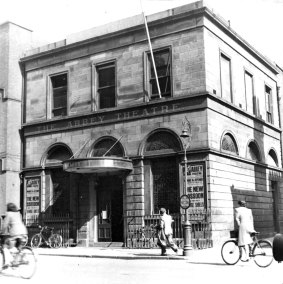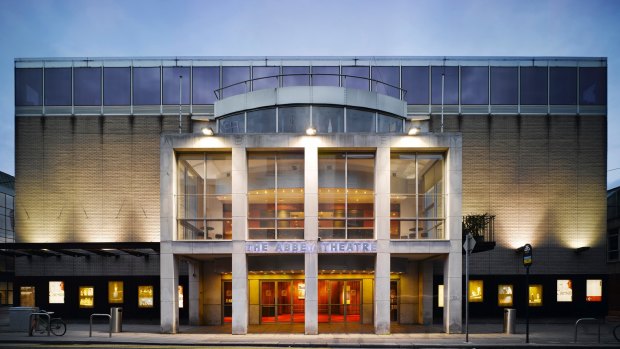This was published 5 years ago
The Abbey Theatre, Dublin: The oldest national theatre in the English-speaking world

Abbey Theatre in 1930.Credit: Alamy
The foyer of Dublin's historic Abbey Theatre is full of middle-aged Goths. Nick Cave is playing an intimate show tonight on a set designed for Ulysses – so these fans hope to sit on stage, close to their idol, at the theatrical cabaret tables gathered around what is usually a pretend Dublin pub.
James Joyce's famously difficult-to-finish 1000-page novel about 24 hours in the life of Dublin has been comically abridged for stage by Dermot Bolger – and features lots of puppets.
Puppets? Nick Cave? Comedy?

Dublin's historic Abbey Theatre.Credit: Ros Kavanagh
Clearly the Abbey isn't a typical national theatre.
Actually, James Hickson points out (ironically since we're in the Irish capital), the Abbey is "the oldest national theatre in the English-speaking world".
Two years after the Irish Free State was formed in 1922 (before becoming the Republic of Ireland in 1937), the newly-formed government began subsidising the Abbey as a crucible of Irish culture.
And yet the Abbey was already promoting Irish culture, long before the Easter Rising of 1916 or the Anglo-Irish Treaty of 1921.
"In fact, this was our national theatre before Ireland became an independent nation," says Hickson.
Hickson – a lecturer at Trinity College's Samuel Beckett Centre as well as the Abbey's chief theatre guide – is explaining the rich heritage of the Abbey in its WB Yeats Lounge, named after the great poet and one of the Abbey's key creators.
Other portraits line the lounge (which serves as the main interval bar). Though some are actors or directors, most are playwrights whose work has been performed here.
There's John Millington Synge (Playboy of the Western World), Lady Augusta Gregory (Spreading the News), Sean O'Casey (Juno and the Paycock, The Plough and the Stars), Brendan Behan (The Quare Fellow).
Two of those plays caused riots, Hickson explains.
The theatre was also part of a rebellion/liberation campaign, had its ornate exterior destroyed by a diverted bus driver, and was almost burnt to a crisp in the 1950s. But perhaps we should let Hickson go back to the beginning …
The theatre (Amharclann na Mainistreach in Irish) opened in December 1904 in the former Mechanics Hall in Lower Abbey Street, as a venue for Irish theatre. The first night consisted of three one-act plays: On Baile's Strand by Yeats, Spreading the News by Lady Gregory, and Kathleen ni Houlihan, co-written by Yeats and Gregory.
By then, Oscar Wilde was dead and George Bernard Shaw was based in the English home counties.
But Yeats, Lady Gregory, Synge and playwright Edward Martyn (the first president of Sinn Fein) were determined to inspire an Irish literary revival.
Another crucial character in the theatre's history was an Englishwoman, Annie Horniman (whose portrait also resides in the WB Yeats Lounge).
"She was the financier," Hickson says. Born in Manchester, Horniman had theatrical experience (she'd been involved in Shaw's Arms and the Man) and had arrived in Dublin as Yeats' unpaid assistant).
Scandal struck the Abbey in January 1907 when it became the scene of "the Playboy Riots".
"A guy walks into a bar," Hickson begins, explaining why the first night of Playboy of the Western World proved so important to world theatre.
"I'm paraphrasing, but he says, 'I've had an argument with my father and I've killed him'. The assumption of the audience is that this is a law-abiding, god-fearing rural community in western Ireland and they'll hand him into the authorities…
"Lady Gregory sent Yeats a telegram in the interval: 'Play great success'."
However, the telegram proved premature. There's a line in the play about "a drift of females standing in their shifts".
"A shift, in Irish, meant female nightwear," Hickson explains. In retrospect, the riot was clearly premeditated, organised by Irish nationalists who felt the play was not sufficiently political and a slur on the fidelity of Irish women.
"People went crazy," Hickson says. "Irishwomen were supposed to be so virtuous they would never be seen in their nightwear.
"No matter that there was a young doctor who said he'd had to stop himself from standing up and pointing to all the men and women in the audience he was treating for sexually transmitted diseases."
Two decades went by before the next riot.
"O'Casey's The Plough and the Stars was written ten years after the Easter Rising, but it's about the Easter Rising," Hickson continues. "The question it poses is: was it worth it? That was controversial. People died."
Members of the Abbey Theatre – actors, writers, stage crew – also took part in the Easter Rising. There's a plaque commemorating them in the foyer.
One was the poet Peadar Kearney, who wrote the lyrics to The Soldier's Song (now the Irish national anthem) in 1907. A stage assistant and occasional actor, Kearney quit an Abbey theatre tour of England to take part in the Rising, fighting at the Jacob's biscuit factory. He was later interned by the British during the War of Independence.
There were no more riots at the Abbey – only a devastating fire in 1951. For 15 years, the theatre company operated (again ironically) out of the city's now demolished Queen's Theatre (named after Victoria).
During that time, the artistic director would check the derelict building regularly.
"Once he heard a suspicious noise, tap-tap-tap," Hickson says. "He went along the corridor to investigate and opened the door …
"There was Brendan Behan, using it as an unpaid office because he'd got spare keys."
The national theatre returned to Lower Abbey Street in 1966.
Since then, a new breed of Irish playwrights have had their work pioneered at the Abbey.
Brian Friel (Dancing at Lughnasa), Tom Murphy (The Gigli Concert), Hugh Leonard (Da) and Marina Carr (Bog of Cats) have all seen their work expand to Broadway and London's West End.
More are to come, Hickson says. The Abbey is just as alive and relevant now as it was more than a century ago.
Cathay Pacific flies from Australia to Dublin four times a week, via Hong Kong. See cathaypacific.com
TOUR
Tours usually include the rehearsal studio, the hair and make-up room and other off-limit back-stage experiences. See abbeytheatre.ie
Steve Meacham travelled as a guest of Cathay Pacific and Tourism Ireland.
FIVE OTHER HISTORIC THEATRES YOU SHOULD SEE
TEATRO AMAZONAS, MANAUS, BRAZIL
In the middle of Brazil's Amazon rainforest is one of the most beautiful 19th century Belle Epoque follies ever built. Paid for by "rubber barons" and designed by the exquisitely named Italian architect Celestial Sacardim, the most remote opera house in the world took 15 years to build. Best to book ahead, visitbrasil.com/en/destinos/manaus
SHAKESPEARE'S GLOBE, LONDON, UK
Sure, this isn't exactly historic since it was only opened in 1997, a labour of love (and money) by the late American actor and director, Sam Wanamaker. But it is a near-as-damn-it replica of the open air Globe where the first performances of Hamlet, Othello and Romeo and Juliet were seen. Fortunately, the toilets and bars are more Elizabeth II-era. See shakespearesglobe.com
BOLSHOI THEATRE, MOSCOW, RUSSIA
Even of you know nothing about ballet, you'll have heard of the Bolshoi. Its ballet company is the biggest in the world, with more than 200 dancers – and has outlasted Czars, Bolshevik revolutions and Soviet dictators. Re-opened in 2011 after a six year renovation, it remains one of the greatest places to watch ballet – or opera! See bolshoi.ru/en
NATIONAL NOH THEATRE, TOKYO, JAPAN
Don't judge the theatre from its horrible exterior, or its youth (it was opened in 1983). This is the place to be introduced to the traditional Japanese form of song-and-dance drama which dates back to the 14th century. If you're bored, revel in the high-tech seats (with English translations) and admire the 400-year old cypress trees which make up the elaborate stage. See ntj.jac.go.jp
FORD'S THEATRE, WASHINGTON DC, US
Nobody would remember Our American Cousin, a three-act farce written by English playwright Tom Taylor, except for one thing. It was the play US President Abraham Lincoln was watching when he was assassinated by actor, Confederate zealot and white supremacist John Wilkes Booth on April 14, 1865. The theatre is still open for tours and shows. See fords.org
Sign up for the Traveller Deals newsletter
Get exclusive travel deals delivered straight to your inbox. Sign up now.